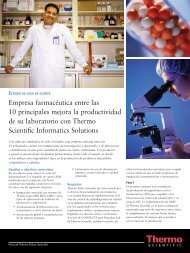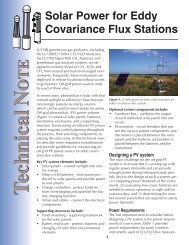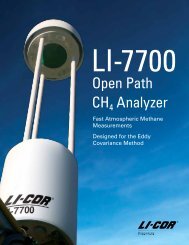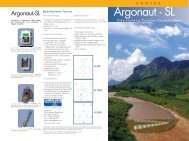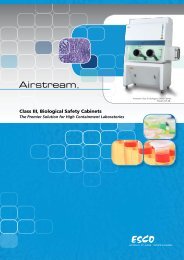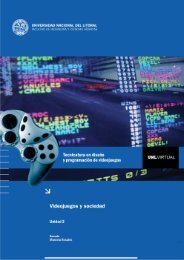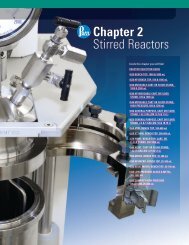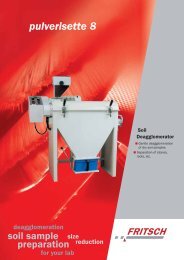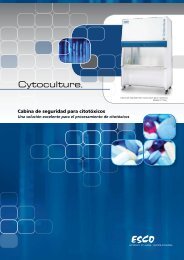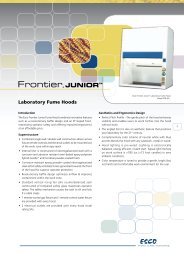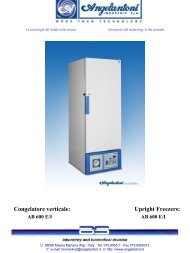Water Vapor Application Note
Water Vapor Application Note
Water Vapor Application Note
You also want an ePaper? Increase the reach of your titles
YUMPU automatically turns print PDFs into web optimized ePapers that Google loves.
The Importance of <strong>Water</strong> <strong>Vapor</strong>Measurements and Corrections<strong>Application</strong> <strong>Note</strong> #129APPLICATION NOTE<strong>Water</strong> vapor is known to influence the measurementof carbon dioxide by infrared gas analysis in severalways, which can lead to significant measurementerrors. Spectral cross-sensitivity due to absorptionband broadening, and inherent instrument crosssensitivitycan both cause overestimations of CO 2mole fraction in samples containing water vaporwhen their effects are not accounted for. Dilution ofsamples by the addition of water vapor may not beimportant when measuring actual CO 2 molefractions, but can lead to significant errors in fluxmeasurements. In this note we describe the basis ofeach of these three processes and discuss how eachcan affect the measurement of CO 2 .Infrared Absorption by Gases andAbsorption Band BroadeningAt the sub-molecular scale the positions of atomswithin molecules are not entirely fixed. As theymove they stretch and bend their bonds, creatingvibrations within the molecule. Energy differencesbetween the possible vibrational states that resultfrom this movement make it possible for the moleculeto absorb infrared radiation. Changes inangular momentum as the molecule rotates aboutits axis can also cause infrared radiation to beabsorbed. The energy differences resulting fromchanges in the vibrational and rotational states ofthe molecule cause fluctuations in its dipolemoment. These oscillations interact with the alternatingelectrical field of electromagnetic radiationand if the frequencies of oscillation match, theradiation will be absorbed by the molecule.Since the frequency of oscillation for electromagneticradiation (ν) is the inverse of its wavelength(λ=1/ν) and the various energy states that lead to itsabsorption by a molecule are the result of themolecule's structure, the absorption of infraredradiation is both wavelength and absorber speciesdependent. For a given molecular species, absorptionof infrared radiation will occur in bands atvarious wavelengths across the infrared region ofthe spectrum (Figure 1A). Each of these absorptionbands is comprised of individual absorption lines(Figure 1B) that result from rotational transitions,and have a generally Lorentzian line shape describedbyS αkv ( ) =π ( v− v0 )2 + α2 (1)where k(ν) is the absorption coefficient k of radiationat frequency ν, S is the line strength, (ν-ν 0 ) isthe change in frequency across the absorption lineand α is the absorption line half width.Figure 1: Absorption spectrum of CO 2 . Carbondioxide absorption data from HITRAN96 (Rothmanet al. 1998). A. The absorption spectrum of CO 2 inthe infrared region of the electromagnetic spectrum.B. The absorption of CO 2 in the 4.2 μm region.For infrared gas analysis with LI-COR gas analyzers,we are interested in measuring the total absorptionof infrared light across a given waveband to determineabsorber species concentration. The totalabsorption measured by the analyzer, A is inprinciple the result of integrating the absorptionacross the entire band as shown byA = A'( v) dv∫ (2)where A'(ν) is the absorption of infrared radiation ata given radiation frequency, and is given by Beer-Lambert's LawA' ( v) = 1 −exp[ −k( v) wl](3)where w is the absorber concentration and l is theoptical path length (Burch and Williams 1964).These relationships form the basic principles behindAB
Electrical cross-sensitivity: Since absorption is not directlymeasureable, it is calculated from the transmittance ofradiation through the sample asA= 1−ΦiΦ (12)owhere Φ i is the transmitted radiant power in the presence ofthe absorber species and Φ o is the transmitted radiant powerin the absence of the absorber species. The terms Φ i and Φ ocan be determined from measurements at two differentwavebands, one centered on an absorption band of thetarget species (in-band) and one centered in a region of noabsorption by the target species (out-of-band), or by comparingmeasurements between two separate gas samples. Thisleads to two basic approaches to the instrument design,utilizing either a mechanical or optical differential todetermine Φ i and Φ o (Figure 3).In instruments using an optical differential approach, the inandout-of-band filters maybe mounted on a spinning filterwheel that moves them sequentially in line with the detector(Figure 3B). The timing of the wheel is precisely controlledsuch that when the appropriate filter is in line the instrumentmakes a measurement of Φ i or Φ o for either CO 2 or watervapor. In this scheme the time response of the detector cancause an additional form of cross-sensitivity.The detectors used in IRGAs capture radiant energy andconvert it to an electrical current. These detectors can showa small lag in the signal rise and decay from the start andstop of the radiation (i.e. the time period between when afilter comes in and out of line with the detector). While thetime span of this lag is extremely small, when the detectoroutput is sampled at high frequency the decay lag from onefilter can overlap the next filter. In this situation the instrumentcan show a cross-sensitivity between the CO 2 andH 2 O measurements. However, because the overlappingsignal is small the magnitude of this cross-sensitivity is alsosmall.Some LI-COR gas analyzers are known to show a slightcross-sensitivity in their measurements between CO 2 andwater vapor. Those that do include a cross-sensitivity term intheir calibration functions, which corrects for this effect.Because the processes leading to the cross-sensitivity aredue to component-specific properties, each analyzer isindividually characterized for cross-sensitivity during thecalibration procedure. A summary of which LI-COR analyzersinclude a cross-sensitivity correction is included in theappendix. For these analyzers the cross-sensitivity correctionis significantly smaller than that for band broadening.Dilution by foreign gasesUnlike the broadening of spectral lines by foreign gases orinstrument cross-sensitivity, dilution of samples by foreigngases does not cause errors in the actual measurement of theabsorber gas. Rather the correction of concentration data fordilution effects yields a theoretical concentration of acomponent in a gas mixture assuming some concentrationof the diluting gas. As such, adjusting for dilution effects isnot important in all measurements. For measurements where4the goal is simply to know the CO 2 content of a given gassample, a dilution correction may not be needed. However,in situations where comparisons are to be made betweenmole fractions of one component in varying gas mixtures,correcting for the dilution effect can be very important(Penning et al. 1984). A common example is when calculatingcarbon fluxes from measurements of CO 2 mole fractionsin air. If the system used to make the flux measurementsoperates under constant pressure and the sample is not driedbefore reaching the IRGA, the influx of water vapor to thesystem due to transpiration and/or evaporation will cause aproportionate decrease in the sample CO 2 concentration(Figure 4A). Without applying a dilution correction, underthese conditions carbon uptake will be overestimated andcarbon losses will be underestimated. Figure 4B showscorresponding flux calculations for both diluted measurementsand dilution corrected measurements. It is clear thatthe uncorrected measurements indicated a sizable carbonuptake, even though the sample material was inert.Figure 4: An example of dilution in an open flow-throughsystem. A. Sample chamber CO 2 mole fractions (bluecircles) were measured with an inert transpiring body (wetfilter paper) enclosed in an O-ring sealed chamber attachedto the LI-6400XT. During measurements the chamber wassupplied with a gas of known CO 2 mole fraction (400 μmol/mol) and transpiration was varied by adjusting the initialmoisture content of the air stream. The decrease in samplechamber CO 2 mole fraction is real and becomes larger asthe transpiration rate increases. B. The apparent assimilationrate (gray circles), calculated without a dilution correction,also increases with transpiration rate, while the actualassimilation rate reported by the instrument (open circles)remained near zero for all the measurements.AB
In practice we are often interested in knowing the molefraction of CO 2 in the absence of water vapor, or standardizingtwo CO 2 measurements to the same water vapor content.In the first case, equation (B6) can be written instandard units of measurement for the two gases asc'c =1 − w / 1000(13)where c is the mole fraction of CO 2 (μmol/mol) in dry air, c'is the measured CO 2 mole fraction (μmol/mol) of wet air,and w is the measured water vapor mole fraction (mmol/mol). In the latter case, correcting one measurement to thewater vapor concentration in another is done by multiplyingone of the measured CO 2 mole fractions by the ratio of thebracketed term in equation (B3) for the two measurements,as shown bywcs wr cs ws 1−=r / 10001−ws/ 1000(14)where c wrsis the mole fraction of CO 2 in the sample (μmol/mol) corrected to the water vapor content of the referencemeasurement w r (mmol/mol), c wssis the mole fraction ofCO 2 measured in the sample (μmol/mol), and w s is the watervapor content in the sample (mmol/mol).For flux measurements, equation (13) or (14) may be appliedto raw concentration data or a dilution correction may beembedded within the flux equation. Figure 5 providesexamples of some common flux measurements and how adilution correction is applied in each. The appendix on page7 includes a summary of which LI-COR gas analyzers applydilution corrections and how the correction is implemented.Deriving the Dilution CorrectionFor any gas mixture at constant temperature and pressure,an increase in the quantity of one of its components willresult in an equivalent decrease in the quantity of theremaining components. This occurs because, as shown bythe Ideal Gas Law at any given temperature and pressure,only a certain number of molecules (N) can occupy a givenvolume (V)PV= N(B1)RTIf N represents the total number of molecules in a multicomponentgas mixture, then N is equal to the sum of thequantities of its components (n i ), in molesN= ∑ n i(B2)If some quantity of a diluting gas (n d ) is added to thismixture, while pressure and temperature remain constant,then the sum of n i must be reduced by an equivalentamount as shown by∑N = n'i + nd∑N− nd= n'iwhere n’ i is the diluted molar quantity of component i inthe mixture. The term in brackets in equation (B3) representsthe proportion of the total number of moles in themixture comprised by all components excluding thediluting gas. Substituting for N from equation (B2) yieldsn∑⎛ d ⎞ni⎜1−⎟ = n i⎝ N ⎠ ∑ ' (B4)which is solvable for the number of moles of all componentsif the diluting gas were not present. Equation (B4) canbe rewritten in terms of mole fraction by dividing by N toyield∑∑ X'iXi=1 − Xd(B5)where the mole fraction of component i, X i , is equal ton i /N. This can be written for a single component of the gasmixture asX'iXi=1 − X(B6)dto give the mole fraction of component i in the absence ofthe diluting gas.∑⎛ nd⎞N⎜1 − ⎟ = n'i(B3)⎝ N ⎠5
Flux EquationDilution TermOpen SystemFc=f( X' cr −X) X = X'scs wrcs wrcs⎡1−X⎢⎣1−Xwrws⎤⎥⎦Eddy Correlation -open path analyzercv wTFc= w c + ⎛ ⎞w vc⎝ ⎜ ⎠⎟ + ⎛+ ⎞ ' '' ρ' μ ρ ' ρ'⎜ μ ρ ⎛1ρ⎟ ρ μ ρ c⎞ρ μ ρ v wT⎜ w vρc⎝ ρ ⎠ T ⎝ ρ ⎠⎟ + ⎛+ ⎞ ' '' ' ⎜1⎝ ρ⎟⎠ TaaaaClosed SystemFcVP dXc= XRTs dtcX'c=1 − XwEddy Correlation -closed path analyzerF= ρ w' XXc a ccX'c=1 − XwF c flux of CO 2 ; f flow; X’ cr reference cell CO 2 mole fraction; X’ cs sample cell CO 2 mole fraction; X wr reference cell water vapor molefraction; X ws sample cell water vapor mole fraction; s area; X cs wr dilution corrected sample cell CO 2 mole fraction; dX c /dt change indilution corrected CO 2 mole fraction with time; X c dilution corrected CO 2 mole fraction; X’ c measured CO 2 mole fraction; X w watervapor mole fraction; w' fluctuation in mean vertical wind speed; ρ’ c fluctuation in mean CO 2 density; μ ratio of molecular weights of dryair and water vapor; ρ c mean CO 2 density, ρ a mean dry air density; ρ v mean water vapor density; T' fluctuation in mean air temperature;T mean air temperatureFigure 5: How dilution corrections are applied for some common flux measurements. For an open flow-through system suchas the LI-6400XT, the correction is used to adjust the sample cell CO 2 mole fraction to the water vapor content in thereference cell. For a closed transient system like the LI-8100 and for Eddy Correlation measurements using a closed pathanalyzer like the LI-6262, the correction can be applied to the measured CO 2 mole fraction before the flux calculation isdone. For Eddy Correlation measurements made with an open path analyzer such as the LI-7500, the dilution correctionoccurs as part of the Webb-Pearman-Leuning (WPL) correction which corrects for apparent fluxes due to both heat and watervapor (Webb et al. 1980). For a summary of the derivations of these equations, see Welles and McDermitt 2005.6
Appendix: Summary of water vapor corrections applied in LI-COR gas analyzers.InstrumentSpeciesdetectedBand BroadeningCoefficient (a w )CrosssensitivityDilutioncorrectionImplementationLI-800CO 2NoneNoLI-820CO 2NoneNoLI-840CO 2andH 2O1.45H 2O on CO 2NoLI-840ACO 2andH 2O1.45*H 2O on CO 2NoLI-6200CO 2andH 2O †NoneYesCarbon dioxide mole fraction is notdilution corrected, but a transpirationcorrection is applied in the photosynthesisequation.LI-6251CO 21.57NoBand broadening and dilution correctionsare not applied by the instrument. Theycan be applied to the data post collectionfollowing the instructions in the usermanual.LI-6252CO 21.57Yes(optional)Band broadening and dilution correctionscan be applied if the water vaporconcentration is supplied to the instrumentvia an external sensor. Thedilution correction is the same asapplied in the LI-6262.LI-6262LI-6400 andLI-6400XTLI-7000CO 2andH 2OCO 2andH 2OCO 2andH 2O1.571.51.57LI-7200 CO 2and 1.15 H 2O on CO 2YesH 2OCO 2on H 2OYes(optional)YesNoUsing FCT 76 a dilution correction canbe applied, which adjusts the sampleCO 2mole fraction to the same watervapor content as that in the referencecell.A dilution correction is applied in thephotosynthesis equaiton. Whenconfigured as a closed system, theinstrument calculates the CO 2molefraction relative to dry air.Calculates CO 2and water vapor molefractions relative to dry air.LI-7500 CO 2and 1.15 H 2O on CO 2NoH 2OCO 2on H 2OLI-7500ALI-8100CO 2andH 2OCO 2andH 2O1.151.45H 2O on CO 2CO 2on H 2OH 2O on CO 2CO 2on H 2ONoYesCalculates the CO 2mole fractionrelative to dry air for use in flux calculations.* Above 10,000 μmol/mol the instrument uses a value of 1.3 and above 20,000 μmol/mol it uses 1.2.† The LI-6200 does not measure water vapor with an IRGA. It uses a capacitance-based sensor in the measurement chamber.7
Literature CitedBurch, D.E. and D. Williams. 1964. Test of theoretical band model approximations. Applied Optics 3:55-61Burch, D.E., E.B. Singleton and D. Williams. 1962. Absorption line broadening in the infrared. Applied Optics 1:359-363McDermitt, D.K., J.M. Welles and R.D. Eckles. 1993. Effects of temperature, pressure and water vapor on gas phase infraredabsorption by CO2. LI-COR, Inc.Parkinson, K.J. 1971. Carbon dioxide infra-red gas analysis. Journal of Experimental Botany 22:169-176Penning de Vries, F. W. T., J. W. J. Akkersdijk and J. L. P. van Oorschot. 1984. An error in measuring respiration and photosynthesisdue to transpiration. Photosynthetica 18:146-149Rothman, W.C., C.P. Rinsland, A. Goldman, S.T. Massie, D.P. Edwards, J.M. Flaud. A. Perrin, C. Camy-Peyret, V. Dana, J.Y.Mandin, J. Schroeder, A. McCann, R.R. Gamache, R.B. Wattson, K. Yoshino, K.V. Chance, K.W. Jucks, L.R. Brown, V.Nemtchinov, and P. Varanasi. 1998. The HITRAN molecular spectroscopic database and HAWKS (HITRAN AtmosphericWorkstation). 1996 ed. Journal of Quantitative Spectroscopy & Radiative Transfer 60:665-710Webb, E.K., G.I. Pearman, and R. Leuning. 1980. Correction of flux measurements for density effects due to heat and watervapor transfer. Quarterly Journal of the Royal Meteorological Society 106:85-100Welles, J.M. and D.K. McDermitt. 2005. Measuring carbon dioxide in the atmosphere. Micrometeorology in agriculturalsystems, Agronomy Monograph no. 47:287-320®4647 Superior Street • P.O. Box 4425 • Lincoln, Nebraska 68504 USANorth America: 800-447-3576 • International: 402-467-3576 • FAX: 402-467-2819 • envsales@licor.com • envsupport@licor.com • www.licor.comIn Germany and Norway – LI-COR Biosciences GmbH: +49 (0) 6172 17 17 771 • envsales-gmbh@licor.com • envsupport-gmbh@licor.comIn UK and Ireland – LI-COR Biosciences UK Ltd.: +44 (0) 1223 422102 • envsales-UK@licor.com • envsupport-UK@licor.comIRG4-110 Printed in USA.




